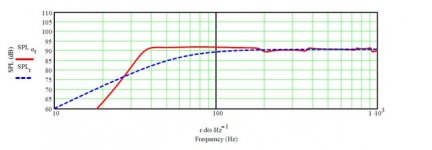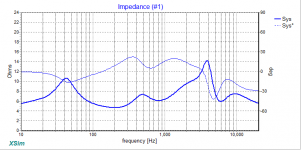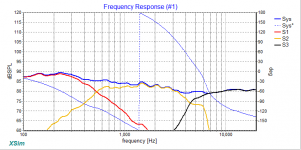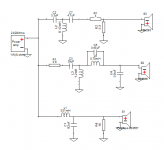I'm still cooped up during covid, and needed a project so I pulled a pair of 5-1/2" Tymphany SDS drivers out of the closet and decided to build a small 2-way out of them. If they work decently well, they will wind up flanking the TV in the family room where my wife spends a lot of time sewing. Limited bass and output are fine for the application. No sub will be used. A pair of Peerless DQ25SC16-04 tweeters arrived today, chosen for their decent reputation, reasonable cost and small size that should allow fairly close c-c spacing. I'll first set them up with the MiniDSP, and take measurements to see if I can design a decent passive crossover.
Not wanting to build stands, I turned to MJK's MLTL worksheet to see if I could come up with a reasonable floor-standing box using the T/S parameters as measured with the Smith and Larsen WT2.
I have attached the output from the worksheet, as well as the parameters used and a snapshot of the predicted frequency response. Short version, 36" tall x 6.5" wide x 6" deep, 2" dia x 4.5" port. Does this look like a reasonable design? The driver Qt is a bit high, so modeling a conventional BR in WinISD tends to give responses with a rise around 100 Hz, or a peaking response at the port tuning. This looks quite flat, and predicts better excursion control at the bottom end (is that due to additional resistance to flow in the narrow enclosure?), but will that pan out in a decent real-room bottom end?
Any comments or criticism would be welcome, thanks!
Bill
Not wanting to build stands, I turned to MJK's MLTL worksheet to see if I could come up with a reasonable floor-standing box using the T/S parameters as measured with the Smith and Larsen WT2.
I have attached the output from the worksheet, as well as the parameters used and a snapshot of the predicted frequency response. Short version, 36" tall x 6.5" wide x 6" deep, 2" dia x 4.5" port. Does this look like a reasonable design? The driver Qt is a bit high, so modeling a conventional BR in WinISD tends to give responses with a rise around 100 Hz, or a peaking response at the port tuning. This looks quite flat, and predicts better excursion control at the bottom end (is that due to additional resistance to flow in the narrow enclosure?), but will that pan out in a decent real-room bottom end?
Any comments or criticism would be welcome, thanks!
Bill
Attachments
you might want to try to increase the damoing to better suit being in a room, but that could be as little as increasing stuffing density.
dave
dave
If max flat is what you want, then you 'nailed' it! 😉
As Dave noted though, do final tuning with the speakers in place with critically damping the vents often being sufficient IME, or in the bad old days, just 'stick a [cotton] sock in it'. 😉
Click test: Click Test | GM210 | Flickr
As Dave noted though, do final tuning with the speakers in place with critically damping the vents often being sufficient IME, or in the bad old days, just 'stick a [cotton] sock in it'. 😉
Click test: Click Test | GM210 | Flickr
Hello from Australia
I was thinking of doing a similar project with this Peerless and found a MLTL design by Peter Blix through a Google search. Similar dimensions to your proposed cabinet, but a smaller port.
I don't think the calculations were provided but detailed plans and stuffing instructions were provided. The project seemed to be public domain.
I didn't go ahead with it - built a bookshelf instead - so don't know how it sounds, I'm sorry.
Geoff
I was thinking of doing a similar project with this Peerless and found a MLTL design by Peter Blix through a Google search. Similar dimensions to your proposed cabinet, but a smaller port.
I don't think the calculations were provided but detailed plans and stuffing instructions were provided. The project seemed to be public domain.
I didn't go ahead with it - built a bookshelf instead - so don't know how it sounds, I'm sorry.
Geoff
Just in case you didn't know: The excursion graph in the worksheet uses the RMS value of excursion, not peak. So the 830656 3.46 mm peak value in the spec sheet is actually 2.46 mm in the worksheet graph.
Thanks for the replies, gents!
Geoff, good find on the existing design. It's tuned a bit lower than mine, good for excursion control, but with the smaller diameter port more likely to chuff and a bigger port wont fit the box. That seems to be a common compromise.
Ern,
I hadn't considered the impact of MJK using RMS excursion, thank you for that. That certainly limits the output of the driver.
While I was bouncing the tradeoffs in my head, I remembered that at one of the Burning Amp festivals I attended I won a pair of old 8" Vifa woofers in the raffle. They don't go high enough to work in a 2-way speaker, but I they should work as the bottom end for a 3-way. The efficiency is about right, 1.5 ft^3 vented goes plenty low and loud enough and will fit the available space. I'm envisioning a mini-Tarkus, scaled down to an 8" woofer and 5-1/4" midrange and that could be fun.
Am I competent to design a 3-way passive crossover? Probably not, but I have measurement tools, XSim, a table saw and all of the drivers, so why not try? It should be fun, and at worst I'll learn a few things without spending too much.
More on this later. It may be time for a sheet of cheap plywood to build a prototype and take some in-box measurements.
Geoff, good find on the existing design. It's tuned a bit lower than mine, good for excursion control, but with the smaller diameter port more likely to chuff and a bigger port wont fit the box. That seems to be a common compromise.
Ern,
I hadn't considered the impact of MJK using RMS excursion, thank you for that. That certainly limits the output of the driver.
While I was bouncing the tradeoffs in my head, I remembered that at one of the Burning Amp festivals I attended I won a pair of old 8" Vifa woofers in the raffle. They don't go high enough to work in a 2-way speaker, but I they should work as the bottom end for a 3-way. The efficiency is about right, 1.5 ft^3 vented goes plenty low and loud enough and will fit the available space. I'm envisioning a mini-Tarkus, scaled down to an 8" woofer and 5-1/4" midrange and that could be fun.
Am I competent to design a 3-way passive crossover? Probably not, but I have measurement tools, XSim, a table saw and all of the drivers, so why not try? It should be fun, and at worst I'll learn a few things without spending too much.
More on this later. It may be time for a sheet of cheap plywood to build a prototype and take some in-box measurements.
With the help of Parts Express Tech Talk members, I made a sim for a three way with the Peerless SDS160PRO (6.5", high Xmax); the 830656; and a Vifa XTSC90-04 tweeter. It was adapted from an existing TMWW sealed design.
Not sure how the Vifas compare with your tweeters, or how the woofers compare, but.
If you can measure the responses - the sim is based on measured, in-box data, not just maker supplied - you could see if this could be adapted to your project. It has quite a few parts, so I suggest doing a few sims and see what you come up with before buying any bits.
HTH
Geoff
Not sure how the Vifas compare with your tweeters, or how the woofers compare, but.
If you can measure the responses - the sim is based on measured, in-box data, not just maker supplied - you could see if this could be adapted to your project. It has quite a few parts, so I suggest doing a few sims and see what you come up with before buying any bits.
HTH
Geoff
Attachments
Last edited:
Geoff,
Thanks for that, another good starting point. Interesting find this AM, the tweeter xover PC used in Tarkus is virtually identical to the one Zaph used with the DQ25 in his ZA5 2-way design. Should put me in the ballpark for a 2k crossover point, an l-pad adjustment might be the only change.
I have the tools for measurement and design: Umik, REW, Woofer Tester 2, a turntable for polars, XSim. VituixCAD is installed too, but haven't tried to learn it yet. It might be fun to turn XMachina loose on the drivers and see what kind of wild network it comes up with.
I plan on building cheap and dirty boxes to mock up this speaker, separate woofer box, small box for mid and tweet, then measure everything in box. I'll start with them actively crossed (miniDSP 4x10) to see that everything mates up well and measure the driver offsets before trying a passive xover. I'm lucky to have a nearby source for Baltic birch plywood to make the final boxes.
It's a blessing that there are so many good software tools available for DIYer's these days. I would never have attempted this 40 years ago when I first started playing with audio.
Thanks for that, another good starting point. Interesting find this AM, the tweeter xover PC used in Tarkus is virtually identical to the one Zaph used with the DQ25 in his ZA5 2-way design. Should put me in the ballpark for a 2k crossover point, an l-pad adjustment might be the only change.
I have the tools for measurement and design: Umik, REW, Woofer Tester 2, a turntable for polars, XSim. VituixCAD is installed too, but haven't tried to learn it yet. It might be fun to turn XMachina loose on the drivers and see what kind of wild network it comes up with.
I plan on building cheap and dirty boxes to mock up this speaker, separate woofer box, small box for mid and tweet, then measure everything in box. I'll start with them actively crossed (miniDSP 4x10) to see that everything mates up well and measure the driver offsets before trying a passive xover. I'm lucky to have a nearby source for Baltic birch plywood to make the final boxes.
It's a blessing that there are so many good software tools available for DIYer's these days. I would never have attempted this 40 years ago when I first started playing with audio.
I plugged the DQ25 raw data into the above sim, it just looks like the L-pad might need to be tweaked to bring down the DQ25 a little as it's more efficient (on paper) than the XTSC. Maybe change R2 in the L-pad to 2 ohms.
I got the data from the maker-supplied graph, generated with "fp trace", so it may not be very accurate.
However, I don't think 2,000 Hz will be a good crossover point for that tweeter as the resonant frequency (Fs) is stated as 1369 Hz: this suggests that your XO point should be at least double that, at least 2800 or higher. The tweeter used in the Tarkus is a Vifa DX25 which has a much lower Fs than the DQ25, plus it's built like a brick ****house.
I'm not familiar with the Zaph design so can't comment on what he did to cross the DQ25 that low.
Geoff
I got the data from the maker-supplied graph, generated with "fp trace", so it may not be very accurate.
However, I don't think 2,000 Hz will be a good crossover point for that tweeter as the resonant frequency (Fs) is stated as 1369 Hz: this suggests that your XO point should be at least double that, at least 2800 or higher. The tweeter used in the Tarkus is a Vifa DX25 which has a much lower Fs than the DQ25, plus it's built like a brick ****house.
I'm not familiar with the Zaph design so can't comment on what he did to cross the DQ25 that low.
Geoff
Last edited:
PS to my previous post: Zaph knows his stuff and I don't!
From his website, about the design with that tweeter: "The Vifa tweeter is crossed over relatively low, since the woofer will be the power handling limitation under common usage"
Geoff
From his website, about the design with that tweeter: "The Vifa tweeter is crossed over relatively low, since the woofer will be the power handling limitation under common usage"
Geoff
Last edited:
However, I don't think 2,000 Hz will be a good crossover point for that tweeter as the resonant frequency (Fs) is stated as 1369 Hz: this suggests that your XO point should be at least double that, at least 2800 or higher.
Hmm, news to me since the ROT unless otherwise stated by the manufacturer is a minimum half octave above Fs = 1369/0.707 = ~1936 Hz/2nd order.
That said, with a 2500 Hz minimum test BW, this strongly implies this is its max power rated minimum XO point, though as Zaph pointed out it's moot with the woofer used.
PS to my previous post: Zaph knows his stuff and I don't!
From his website, about the design with that tweeter: "The Vifa tweeter is crossed over relatively low, since the woofer will be the power handling limitation under common usage"
Geoff
I ran into trouble and noted some others also using lower XO points with the peerless 6.5 and tweeter. 1800hz or so from
Jeff Bagby, and I played with 2-2500, and around 1000 with a big waveguided ‘idea’(lol, failure to turn a perfect shape on a lathe from ‘apple’). But then ultimately gave into dsp which is Just an easier can of worms to fall in deeper with
Happy to defer to people with much more expertise and knowledge than I, the 'double Fs' is just something I've seen talked about many times in various fora. It will obviously depend on the tweeter and XO slopes.Hmm, news to me since the ROT unless otherwise stated by the manufacturer is a minimum half octave above Fs = 1369/0.707 = ~1936 Hz/2nd order.
.
Geoff
The Zapf / Carmody / Millar xovers are a starting point. I'm using a smaller mid (5-1/4 vs. 6-1/2) and prototyping with a miniDSP so I can try various xover points and see what works both for distortion and good off-axis response. If raising the xover point makes sense, then I get some practice using XSim, and the parts for a passive xover should get cheaper, no?
Part of the reason for trying the DQ tweeter was that I've never spent significant time with a metal dome tweeter and wanted to try one, and it seems highly regarded as a high-value (i.e. cheap) option. If it doesn't work for me, there are plenty of other options out there.
Bill
Part of the reason for trying the DQ tweeter was that I've never spent significant time with a metal dome tweeter and wanted to try one, and it seems highly regarded as a high-value (i.e. cheap) option. If it doesn't work for me, there are plenty of other options out there.
Bill
If the DQ tweeter doesn't work for you - and Zaph says nice things about it - you could also try the Vifa BC25TG or the XTSC90.
There are very good, documented projects for those combinations on this Forum and Parts Express Tech Talk. Not sure whether it would be necessary to tweak the crossovers for a MLTL, or how you would do that?
For a few more $ you could go for the Peerless aluminium dome DA25, which I've also used with the 830656. That design is on the MAC/DIY Forum.
Geoff
There are very good, documented projects for those combinations on this Forum and Parts Express Tech Talk. Not sure whether it would be necessary to tweak the crossovers for a MLTL, or how you would do that?
For a few more $ you could go for the Peerless aluminium dome DA25, which I've also used with the 830656. That design is on the MAC/DIY Forum.
Geoff
- Home
- Loudspeakers
- Multi-Way
- Tymphany 830656 MLTL design review




